The order of the flounders (Pleuronectiformes) includes more than 800 species of fish from 16 families. Their distinctive features are a flat body, significantly compressed from the sides, and the placement of the eyes which are shifted to one side of the body.
Bottom fish, lying and swimming on their sides, are found in oceans all over the world, from the Arctic to the Antarctic.
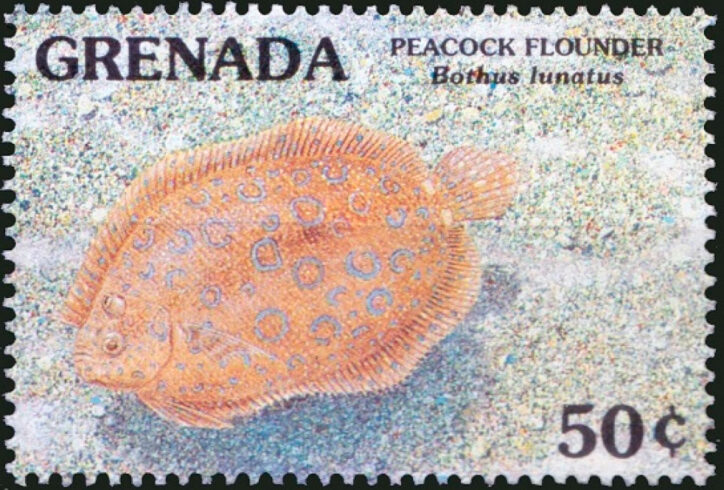
(Bothus lunatus. Grenada postage stamp. collectorbazar.com)
They are mostly predators feeding on other fish, crustaceans, mollusks, and other benthic organisms.
One of the smallest representatives of flounders is Tarphops oligolepis, which lives in the Pacific waters of Japan and Taiwan. On average, its length is about 4.5 cm and it weighs several grams. The largest representative is Atlantic halibut (Hippoglossus hippoglossus), which can be up to 4.7 meters long and weighs up to 320 kilograms.

(Atlantic halibut. Photo by © Mariusz Lubkiewicz. chytej.cz)
In the Adriatic Sea, there are 24 representatives of the order from 5 families.
Bothidae or lefteye flounders is a family of 165 fish species. Their distinctive feature is that most species lie on the bottom on the right side, and their eyes are on the left side. Small thorns grow on the muzzle and near their eyes. They inhabit the warm waters of the Atlantic, Indian and Pacific oceans, feed on small fish and benthic invertebrates.
There are 6 species of the Bothidae family in the Adriatic Sea:
Imperial scaldfish (Arnoglossus imperialis).
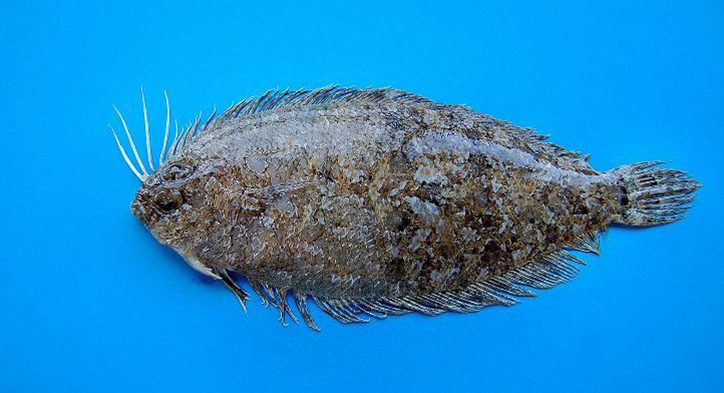
(Imperial scaldfish. Photo by © Cesar Pais Balsalobre. plus.google.com)
It lives at the depth of 20-350 meters, usually 40-200 meters. It prefers to swim near a sandy, muddy bottom next to shell rock and corals. The maximum recorded length is 25 cm; specimens up to 12 cm long are more common. It feeds on small fish and invertebrates. It is a rare inhabitant of the Adriatic Sea found in its southern part.
Scaldback (Arnoglossus kessleri).

(Scaldback. Photo by © Poggiani Luciano. lavalledelmetauro.it)
It lives at depths of up to 200 meters, often found near the coast. It prefers to swim near a sandy and muddy bottom. The maximum recorded length is 10 cm. It feeds on small fish and invertebrates. It is a permanent inhabitant of the Adriatic Sea.
Mediterranean scaldfish (Arnoglossus laterna).

(Mediterranean scaldfish. Photo by © Hans Hillewaert. flickr.com/photos/bathyporeia)
It lives at a depth of 10-200 meters, usually 10-100 meters. It prefers to swim near the muddy bottom. The maximum recorded length is 25 cm; specimens up to 12 cm long are more common. It feeds on small fish and invertebrates. It is a permanent inhabitant of the Adriatic Sea.
Rüppell‘s scaldback (Arnoglossus rueppelii).

(Rüppell’s scaldback. Photo by © Mariano García Rodriguez. fishbase.org)
It lives at the depth of 85-900 meters. The maximum recorded length is 15 cm. It feeds on small fish and invertebrates. It is a permanent inhabitant of the Adriatic Sea.
Thor‘s scaldfish (Arnoglossus thori).
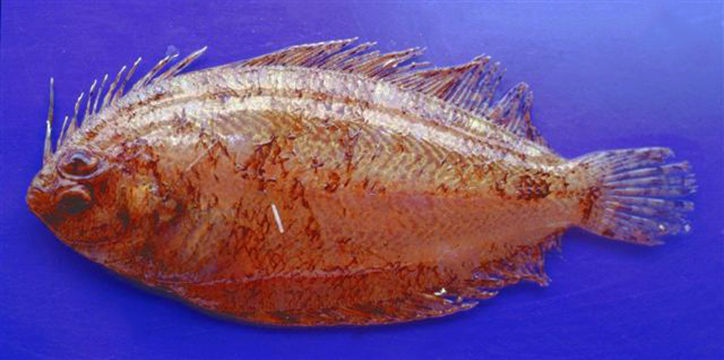
(Thor’s scaldfish. Photo by © Mariano García Rodriguez. fishbase.org)
It lives at a depth of 15-300 meters. The maximum recorded length is 18 cm; specimens that are up to 12 cm long are more common. It feeds on small fish and invertebrates and is a permanent inhabitant of the Adriatic Sea.
Wide–eyed flounder (Bothus podas).
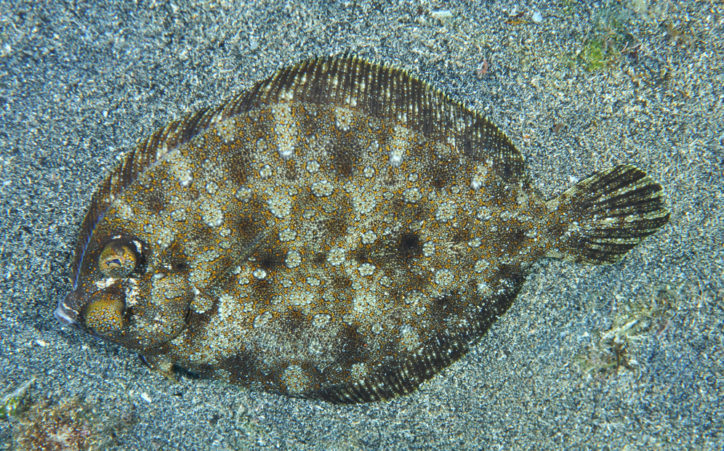
(Wide-eyed flounder. Photo by © jome jome. flickr.com/photos/jomejome)
It lives at a depth of 15-400 meters. It prefers to swim near the sandy and muddy bottom. The maximum recorded length is 45 cm; specimens up to 15 cm long are more common. It feeds on small fish and invertebrates. It is a permanent inhabitant of the Adriatic Sea, more often found in its southern part.
Citharidae or largescale flounders is a family from the order of flounders, which includes 4 genera with seven species of fish, six of which live in the Indian and Pacific Oceans. One representative of the family, spotted flounder (Citharus linguatula), is found in the Adriatic Sea.
Spotted flounder (Citharus linguatula).

(Spotted flounder. Photo by © Federico Pallottino. fishbase.org)
It lives at the depth of up to 300 meters. It prefers to swim near the sandy and muddy bottom. The maximum recorded length is 30 cm; specimens up to 15 cm long are more common. It feeds on small fish and crustaceans. It is a permanent and infrequent inhabitant of the Adriatic Sea, more common in its northern and southern parts.
The Pleuronectidae or righteye flounders family includes 67 fish species from 26 genera. As their name suggests, the eyes in the family representatives are mostly located on the right side of the head, but, in some species, they are on the left side. The representatives of this family are found at the bottom of oceans around the world, and some species, such as the Atlantic halibut (Hippoglossus hippoglossus), are found at depths of up to 2000 meters. Small species prey mainly on invertebrates, while the large ones prey on cephalopods and fish. Many species of the family are objects of commercial fishing.
There are 2 representatives of the righteye flounder family in the Adriatic Sea and they are the following:
European flounder (Platichthys flesus).
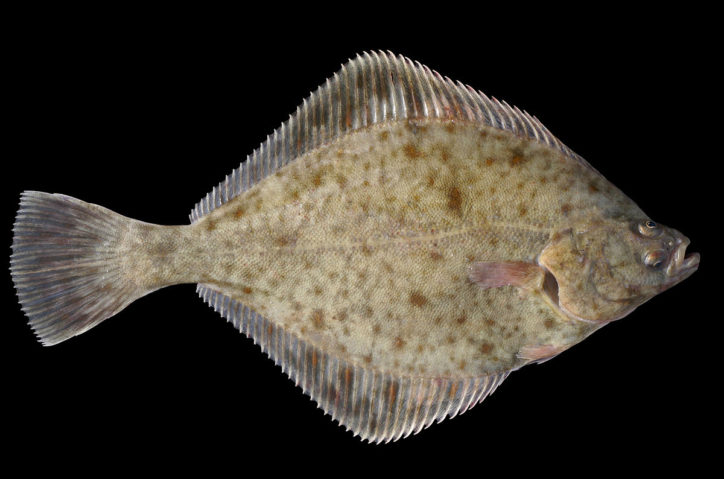
(European flounder. Photo by © Hans Hillewaert. en.wikipedia.org)
It lives at the depth of 1-100 meters. It is the actively migrating fish that comes from the sea to rivers and lakes. Often, it can be found near the mouths of the rivers, in the estuaries, or on bays near the muddy and sandy bottom. The maximum recorded length is 60 cm; specimens up to 50 cm long are usually observed. The maximum weight is 2.9 kilograms. It feeds on small fish and invertebrates. It is a permanent inhabitant of the Adriatic Sea and freshwater bodies of Albania, Bosnia and Herzegovina, Italy, Slovenia, Croatia, and Montenegro.
European plaice (Pleuronectes platessa).
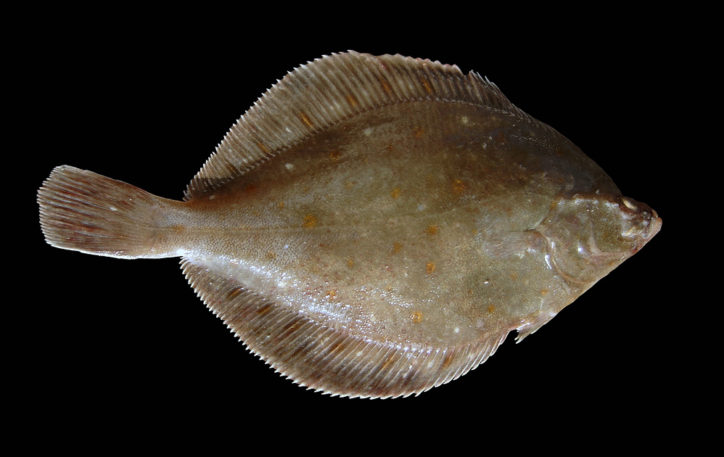
(European plaice. Photo by © Hans Hillewaert. en.wikipedia.org)
It lives at a depth of up to 200 meters, usually 10-50 meters. It prefers to swim near the sandy and muddy bottom. The maximum recorded length is 100 cm; specimens up to 40 cm long are more common. The maximum weight is 7 kg. It feeds mainly on thin-walled mollusks and polychaetes. It is a rare inhabitant of the Adriatic Sea, found in its northern part.
Fish from the Scophthalmidae or turbots family are inhabitants of the North Atlantic Ocean, as well as the Baltic, Mediterranean, and Black seas. The family includes 9 species from 3 genera. Both eyes of such fish are on the left side of the head, the mouth is very large. In the Adriatic Sea, 5 representatives of turbots are found and they are the following:
Four–spot megrim (Lepidorhombus boscii).
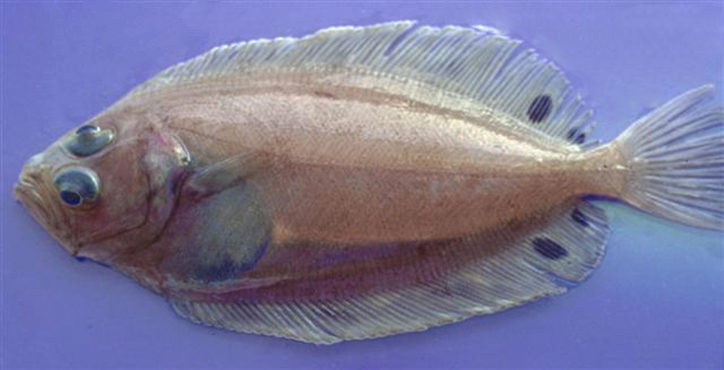
(Four-spot megrim. Photo by © Mariano García Rodríguez. fishbase.org)
It lives at the depth of 7-800 meters. It prefers to swim near the muddy and sandy bottom. The maximum recorded length is 40 cm; specimens up to 20 cm long are often found. It feeds on small fish and invertebrates. It is a rare inhabitant of the Adriatic Sea found in its southern part.
Megrim (Lepidorhombus whiffiagonis).
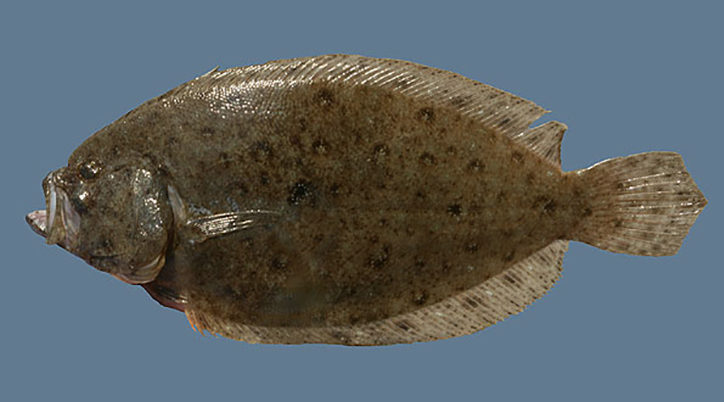
(Megrim. Photo by © Alf Sichting. fishbase.org)
It lives at the depth of 100-700 meters. It prefers to swim near a muddy or sandy bottom. The maximum recorded length is 60 cm; specimens up to 25 cm long are more common. It feeds on small fish, squid, and invertebrates. It is a permanent inhabitant of the Adriatic Sea.
Turbot (Scophthalmus maximus).
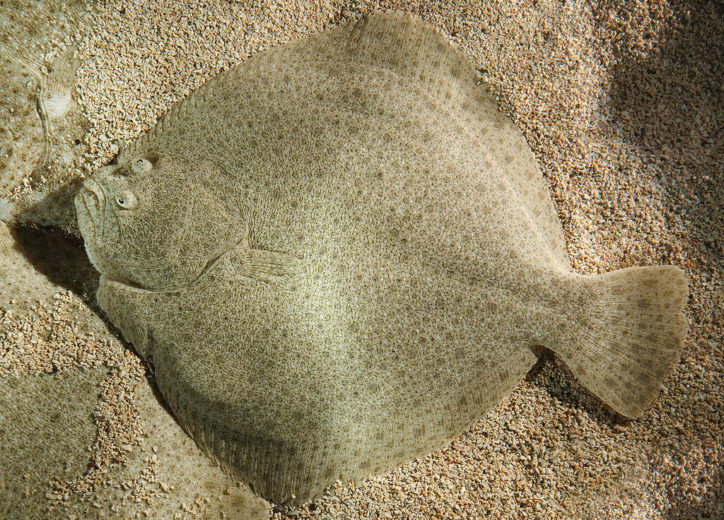
(Turbot. Photo by © Luc Viatour. commons.wikimedia.org)
It lives at the depth of 20-70 meters. It prefers to swim near the sandy and rocky bottom. The maximum recorded length is 100 cm; specimens up to 50 cm long are more common. The maximum weight is 25 kg. It feeds mainly on small fish, less often on large crustaceans and mollusks. It is a permanent inhabitant of the Adriatic Sea.

(Brill. Photo by © Vitaly Giragosov, Antonina Khanaychenko. fishbase.org)
It lives at the depth of 5-50 meters. It prefers to swim near the sandy bottom. The maximum recorded length is 75 cm, specimens up to 30 cm long are more common. The maximum weight is 8 kg. It feeds on small fish and large crustaceans. It is a permanent inhabitant of the Adriatic Sea.
Eckström‘s topknot (Zeugopterus regius).
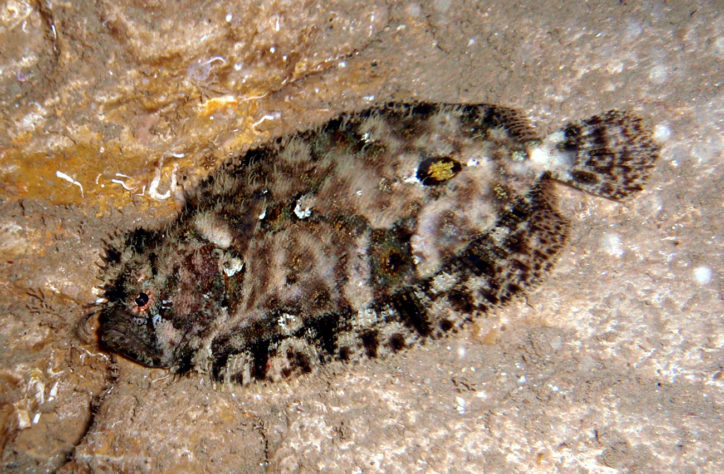
(Eckström’s topknot. Photo by © Víctor Cebollada. commons.wikimedia.org)
It lives at the depth of 10-180 meters. It prefers to swim near a rocky or, rarely, sandy bottom. The maximum recorded length is 20 cm; specimens up to 12 cm long are more common. It feeds on small fish and invertebrates. It is a permanent infrequent inhabitant of the Adriatic Sea.
The Soleidae family includes 180 species from 32 genera. They are widespread mainly in the Indian Ocean, the eastern part of the Atlantic Ocean, as well as the western and central parts of the Pacific Ocean. There are also freshwater species found in Africa, South Asia, New Guinea, and Australia. Both eyes of fish are located on the right side of the body. They feed mainly on small invertebrates. Some species are the objects of commercial fishing. There are 10 representatives of the family in the Adriatic Sea and they include the following:
Solenette (Buglossidium luteum).
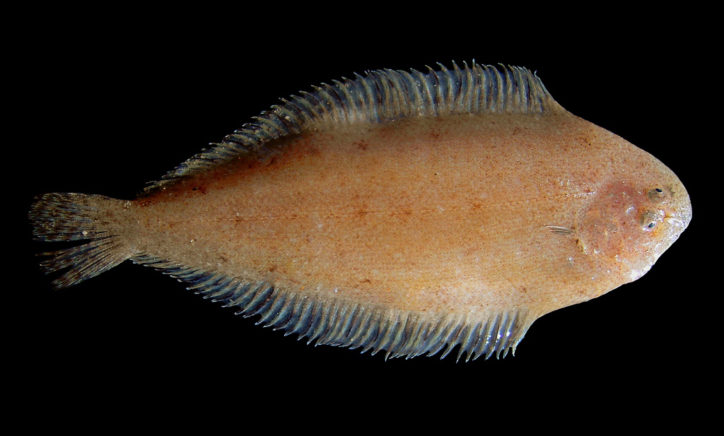
(Solenette. Photo by © Hans Hillewaert. flickr.com/photos/bathyporeia)
It lives at the depth of 5-450 meters, usually 10-40 meters. It prefers to swim near the sandy bottom. The maximum recorded length is 15 cm; specimens up to 8 cm long are more common. It feeds on small benthic crustaceans, bivalve mollusks, and polychaetes. It is a permanent inhabitant of the Adriatic Sea.
Foureyed sole (Microchirus ocellatus).

(Foureyed sole. Photo by © Stefano Guerrieri. fishbase.org)
It lives at the depth of 30-300 meters, prefers to swim near a muddy and sandy bottom. The maximum recorded length is 20 cm; specimens up to 15 cm long are more common. It feeds on crustaceans and mollusks. It is a permanent inhabitant of the Adriatic Sea, more often found in its southern part.
Thickback sole (Microchirus variegatus).
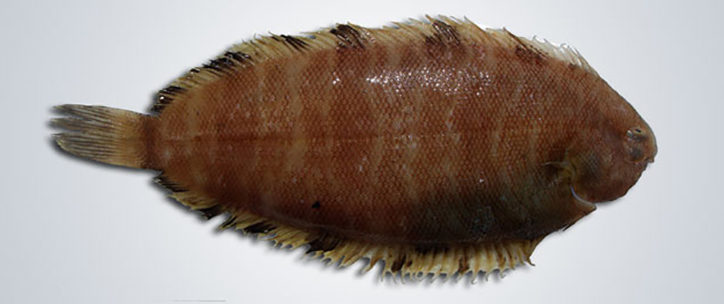
(Thickback sole. Photo by © A.M. Arias. ictioterm.es)
It lives at the depth of 20-400 meters. It prefers to swim near the sandy and muddy bottom. The maximum recorded length is 35 cm; specimens up to 14 cm long are more common. It feeds on small crustaceans, worms, and bivalve mollusks. It is a permanent and infrequent inhabitant of the Adriatic Sea.
Whiskered sole (Monochirus hispidus).

(Whiskered sole. Photo by © Stefano Guerrieri. fishbase.org)
It lives at a depth of 10-250 meters. It prefers to swim near the sandy and muddy bottom. The maximum recorded length is 20 cm; specimens up to 12 cm long are more common. It feeds on crustaceans and mollusks. It is a permanent inhabitant of the Adriatic Sea.

(Adriatic sole. Photo by © A.M. Arias. ictioterm.es)
It lives at the depth of 5-80 meters. It prefers to swim near the sandy and pebble bottom. The maximum recorded length is 35 cm; specimens up to 18 cm long are more common. It feeds on mollusks and sea worms. It is a permanent inhabitant of the Adriatic Sea.
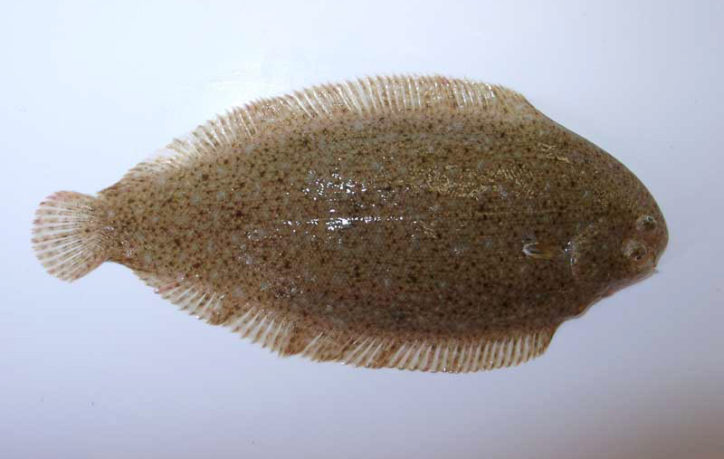
(Sand sole. Photo by © Dr Hilmar Hinz. marlin.ac.uk)
It lives at the depth of 5-350 meters, usually 20-50 meters. It prefers to swim near the sandy, muddy, and pebble bottom. The maximum recorded length is 40 cm; specimens up to 30 cm long are more common. It feeds on crustaceans and mollusks. It is a permanent infrequent inhabitant of the Adriatic Sea.
Blackhand sole (Pegusa nasuta).

(Blackhand sole. Photo by © Roberto Pillon. fishbase.org)
It lives at a depth of 5-80 meters. It prefers to swim near the sandy and muddy bottom. The maximum recorded length is 20 cm. It feeds on crustaceans and mollusks. It is a rare inhabitant of the Adriatic Sea, rarely found in its southern part.
Egyptian sole (Solea aegyptiaca).
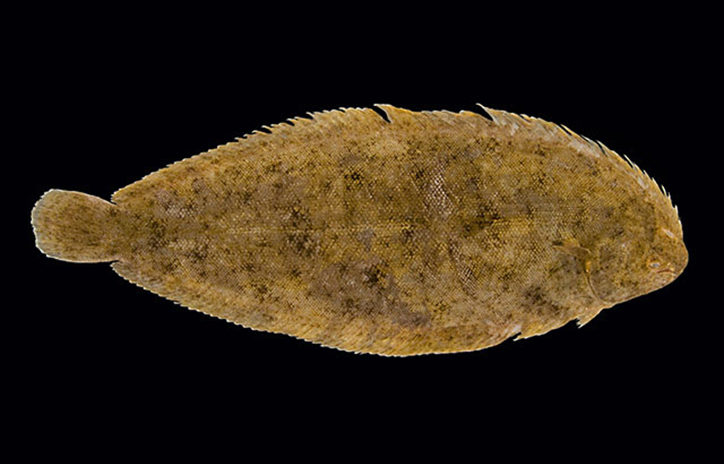
(Egyptian sole. Photo by © Sergey Bogorodsky. fishbase.org)
It lives at the depth of up to 100 meters. It prefers to swim near a muddy and sandy bottom. The maximum recorded length is 65 cm, usually, it is up to 25 cm long. It feeds on benthic invertebrates. It entered the Mediterranean Sea through the Suez Canal. In rare cases, it can be observed in the southern part of the Adriatic Sea.

(Common sole. Photo by © Hans Hillewaert. wikipedia.org)
It lives at depths of up to 150 meters, usually 10-60 meters. It prefers to swim near the sandy and muddy bottom. The maximum recorded length is 70 cm; specimens up to 35 cm long are more common. The maximum weight is 3 kg. It feeds on worms, mollusks, and crustaceans during nighttime. It is a permanent inhabitant of the Adriatic Sea.
Klein’s sole (Synapturichthys kleinii).
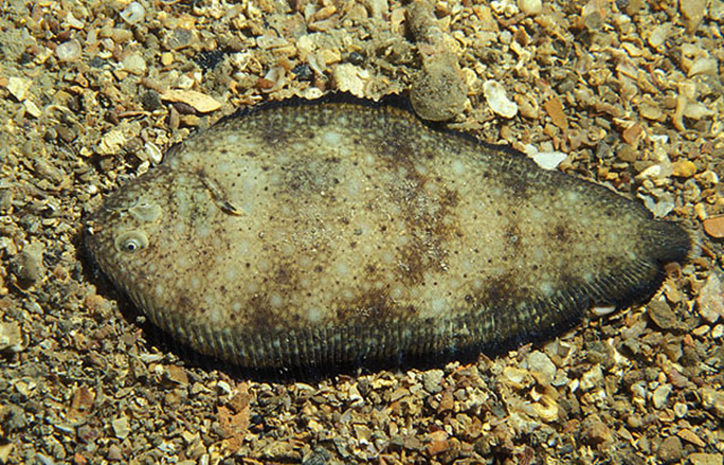
(Klein’s sole. Photo by © Borut Furlan. fishbase.org)
It lives at the depth of 20-460 meters. It prefers to swim near the sandy and muddy bottom. The maximum recorded length is 40 cm; specimens up to 15 cm are more common. It feeds on benthic invertebrates. It is a permanent infrequent inhabitant of the Adriatic Sea.